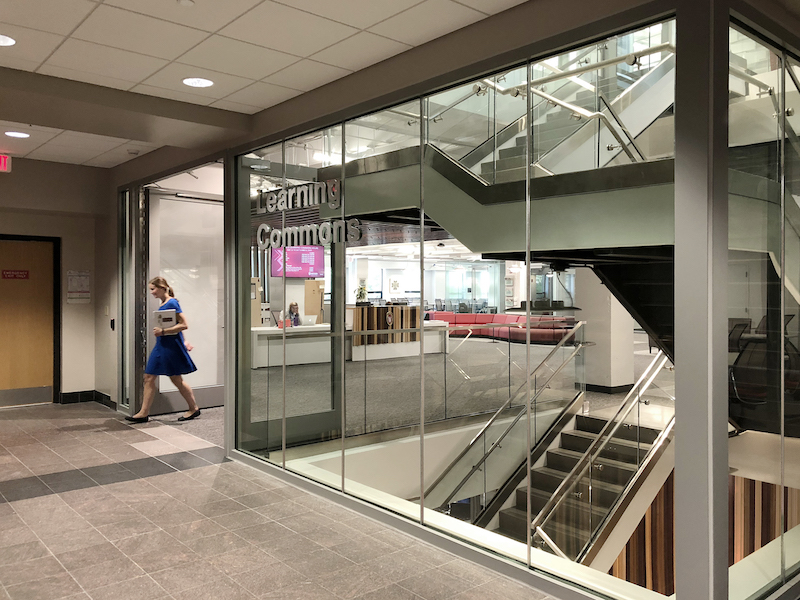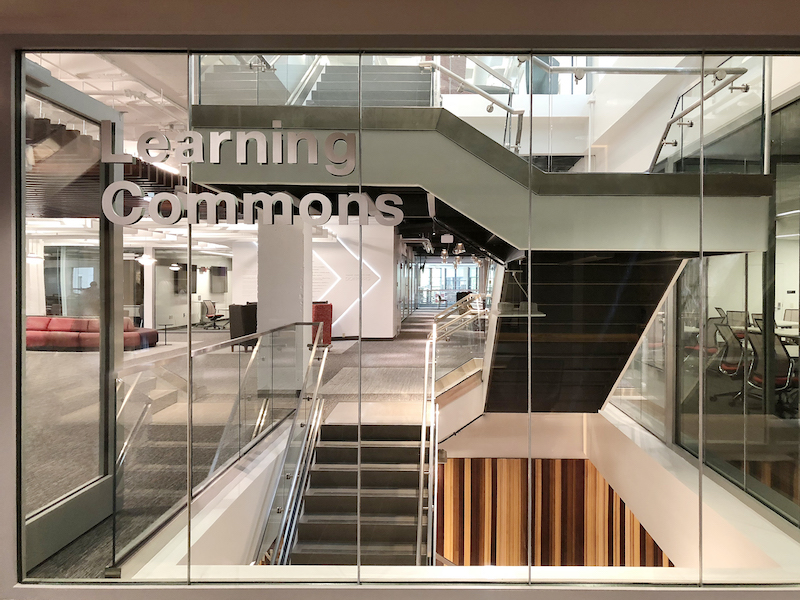When the University of Wisconsin School of Business officially opened the Learning Commons last May, it kicked off the first step in realizing the university’s grand masterplan to renovate the library buildings across the Madison campus. “The design strategy for this Learning Commons space included connecting the east and the west wings of Grainger Hall. Transparency was a key principle for making this happen,” says Scott Kammer, AIA at Potter Lawson. Incorporating transparency between spaces extended to the stairwells as well. To meet the design intent and code requirements, the architects decided to use clear, fire resistive glass walls.
Traditionally, stairwells have been relegated to the back of the building and usually reserved for emergencies as their dark, isolated surroundings made it unappealing for everyday use. The lack of vision and transparency also made it a prime spot for attacks. This all changed with the advent of clear, fire resistive glazing able to meet the ASTM E-119/UL 263 wall standard up to 2 hours. Using transparent building materials that incorporate vision and code-compliance made it possible to design stairwells that are more centrally located instead of being tucked away in the back.
This was the case for the Learning Commons. “The existing building had two separate stairs that only connected two floors each. The centrally located stairwell connected all three levels of the Learning Commons and contributed to the wayfinding experience for the users. It was critical for this stairwell to be as clear as possible to see through the space,” adds Scott.
 Image created by MSR.
Image created by MSR.
During the design phase, Scott worked with Mike White at SAFTI FIRST to explore his options. “Mike was very responsive and answered our questions in a timely manner. He included photos of similar projects, which helped us specify exactly what we needed. He was very helpful in determining if the products would work with our budget at an early stage of design,” says Scott.
To achieve maximum transparency while meeting code requirements, the architects specified 9 ft. tall, clear, fire resistive butt-glazed walls using SuperLite II-XLM in GPX Architectural Series perimeter framing. Instead of vertical mullions, SuperLite II-XLM uses a slim, 6mm butt-joint between the fire resistive glass panels to allow as much transparency as possible while still meeting the fire resistive ASTM E-119/UL 263 wall requirement.
The entrances to the stairwell also maximized vision and transparency without sacrificing safety. Building codes in the USA limit ceramics and other fire protective glazing to 100 sq. in. in the vision panels of 60-90 minute doors in interior exit stairways, ramps and exit passageways regardless if the building is fully sprinklered. To exceed the 100 sq. in. door vision panel limitation, fire resistive glazing tested to ASTM E-119/UL 263 must be used.
 Photo: Olivia Nass.
Photo: Olivia Nass.
That’s exactly what the architects did for this project. For maximum vision and transparency, they specified full-vision temperature rise doors using an ASTM E-119/UL 263 rated assembly comprised of GPX Architectural Series Doors with SuperLite II-XL glazing. The doors also matched the 9-ft. height of the clear, fire resistive butt-glazed panels adjacent to it. With other aluminum temperature rise doors having a maximum height of 8 ft. tall, going with the GPX Architectural Series aluminum temperature rise door at the full 9 ft. height eliminated the need for a transom above the door. These doors do not require a mid-rail and were supplied with custom access hardware at the architect’s request for enhanced security.
SAFTI FIRST worked closely with Omni Glass & Paint during the installation phase. Even though fire resistive butt-glazed walls are a relatively new product in the market, the installation was a pretty smooth process. “I spoke with our installers and they did not see much of a difference in the captured and butt-glazed systems as far as ease of installation,” says Robert Leffel of Omni Glass & Paint. “The service from SAFTI FIRST was good. They did all they could to minimize delays,” he adds. SAFTI FIRST’s sales and project management teams were in constant communication with Omni throughout the bidding, submittal, fabrication and delivery stages.
The result is a visually stunning, code-compliant stairwell enclosure that helps connect the various spaces in this state-of-the-art Learning Commons that is sure to be enjoyed by students, faculty and visitors for years to come.
Related Stories
| Nov 16, 2010
NFRC approves technical procedures for attachment product ratings
The NFRC Board of Directors has approved technical procedures for the development of U-factor, solar heat gain coefficient (SHGC), and visible transmittance (VT) ratings for co-planar interior and exterior attachment products. The new procedures, approved by unanimous voice vote last week at NFRC’s Fall Membership Meeting in San Francisco, will add co-planar attachments such as blinds and shades to the group’s existing portfolio of windows, doors, skylights, curtain walls, and window film.
| Nov 11, 2010
Saint-Gobain to make $80 million investment in SAGE Electrochromics
Saint-Gobain, one of the world’s largest glass and construction material manufacturers, is making a strategic equity investment in SAGE Electrochromics to make electronically tintable “dynamic glass” an affordable, mass-market product, ushering in a new era of energy-saving buildings.
| Nov 11, 2010
Saint-Gobain to make $80 million investment in SAGE Electrochromics
Saint-Gobain, one of the world’s largest glass and construction material manufacturers, is making a strategic equity investment in SAGE Electrochromics to make electronically tintable “dynamic glass” an affordable, mass-market product, ushering in a new era of energy-saving buildings.
| Nov 3, 2010
First of three green labs opens at Iowa State University
Designed by ZGF Architects, in association with OPN Architects, the Biorenewable Research Laboratory on the Ames campus of Iowa State University is the first of three projects completed as part of the school’s Biorenewables Complex. The 71,800-sf LEED Gold project is one of three wings that will make up the 210,000-sf complex.
| Nov 3, 2010
Public works complex gets eco-friendly addition
The renovation and expansion of the public works operations facility in Wilmette, Ill., including a 5,000-sf addition that houses administrative and engineering offices, locker rooms, and a lunch room/meeting room, is seeking LEED Gold certification.
| Nov 3, 2010
Sailing center sets course for energy efficiency, sustainability
The Milwaukee (Wis.) Community Sailing Center’s new facility on Lake Michigan counts a geothermal heating and cooling system among its sustainable features. The facility was designed for the nonprofit instructional sailing organization with energy efficiency and low operating costs in mind.
| Nov 3, 2010
Rotating atriums give Riyadh’s first Hilton an unusual twist
Goettsch Partners, in collaboration with Omrania & Associates (architect of record) and David Wrenn Interiors (interior designer), is serving as design architect for the five-star, 900-key Hilton Riyadh.
| Nov 3, 2010
Virginia biofuel research center moving along
The Sustainable Energy Technology Center has broken ground in October on the Danville, Va., campus of the Institute for Advanced Learning and Research. The 25,000-sf facility will be used to develop enhanced bio-based fuels, and will house research laboratories, support labs, graduate student research space, and faculty offices. Rainwater harvesting, a vegetated roof, low-VOC and recycled materials, photovoltaic panels, high-efficiency plumbing fixtures and water-saving systems, and LED light fixtures will be deployed. Dewberry served as lead architect, with Lord Aeck & Sargent serving as laboratory designer and sustainability consultant. Perigon Engineering consulted on high-bay process labs. New Atlantic Contracting is building the facility.
| Nov 2, 2010
Cypress Siding Helps Nature Center Look its Part
The Trinity River Audubon Center, which sits within a 6,000-acre forest just outside Dallas, utilizes sustainable materials that help the $12.5 million nature center fit its wooded setting and put it on a path to earning LEED Gold.
| Oct 13, 2010
Prefab Trailblazer
The $137 million, 12-story, 500,000-sf Miami Valley Hospital cardiac center, Dayton, Ohio, is the first major hospital project in the U.S. to have made extensive use of prefabricated components in its design and construction.














